Menu
-
MenuInapoi
- Home
-
Categorii
-
-
Categorii
-
Semințe de legume
-
Soiuri după țară
- Soiuri din Armenia
- Soiuri din BiH
- Soiuri din Croația
- Soiuri din Franța
- Varieties from Germany
- Varieties from Greece
- Varieties from Hungary
- Soiuri din India
- Varieties from Italy
- Soiuri din Japonia
- Soiuri din Macedonia de Nord
- Varieties from Peru
- Varieties from Russia
- Varieties from Serbia
- Soiuri din Slovenia
- Varieties from Spain
- Varieties from Thailand
- Soiuri din Turcia
- Varieties from USA
- Semințe de roșii
- Semințe de porumb
- Familia Dovleac
- Familia Bean
- Semințe de castraveți
- Seminte de ardei gras
- Familia morcovului
- Familia ceapa
- Semințe de salată verde
- Familia cartofilor
- Familia de varză
- Semințe de ridiche
- Familia sfeclei
- Semințe de pepene verde
- Semințe de pepene galben
- Semințe de conopidă
- Familia de floarea soarelui
-
Soiuri după țară
- Semințe de fructe
- Seminte de Chili Peppers
- Semințe de plante medicinale
- Semințe de plante cățărătoare
- Copaci - Arbust - Semințe
- Semințe de palmier
- Semințe de ierburi ornamentale
- Semințe de tutun
-
Semințe de legume
-
-
-
-
- PRODUSE NOI
- Crează un cont
- Livrare - Plata
- FAQ
Last Product Reviews
Out of the two seeds, one germinated and the other one was dead and floatin...
By
 Riikka H on 07/03/2024
Riikka H on 07/03/2024
Verified Purchase
Sunt 70 produse.
Se afiseaza 61-70 din 70 produs(e)

Planta gigantica (cu fructe gigantice)

XXL Halloween, Jack’O...
Pret
8,45 €
(SKU: VG 7 (10g))
Seeds Gallery EU,
5/
5
<h2><strong>Halloween, Jack’O Lantern Pumpkin Seeds</strong></h2><h2><span style="color:#ff0000;"><strong>Price for Package of 10 grams (4-6 seeds per gram).</strong></span></h2><p>Just like its name, the Halloween Pumpkin, or also known as the Jack’O Lantern, is the perfect porch decoration for Halloween! This variety is also a popular pumpkin standard. Halloween is easy to grow a pumpkin that will give you the greatest patio decoration around!</p><p>Medium late variety, vegetation length about 100 days. It has large and uniform fruits, bright orange in color, with a solid bark suitable for "carving" and drilling. It is intended for fresh consumption.</p>
VG 7 (10g)


Planta rezistenta la frig si inghet
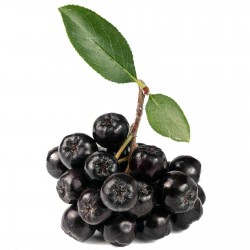
1000 Seeds Chokeberry...
Pret
11,00 €
(SKU: V 29 (4g))
Seeds Gallery EU,
5/
5
<h2><strong>1000 Seeds Chokeberry (Aronia melanocarpa)</strong></h2>
<h2><span style="color: #ff0000;"><strong>Price for Package of 1000 seeds.</strong></span></h2>
<p>Aronia melanocarpa is an extraordinary medicine plant that has been developed in Poland. It has an incredible array of health qualities. Known as Chokeberry, the native Americans used it to prepare pemmican (dried meat). It has a higher concentration of vitamin C than blackcurrants, but it also contains a host of other valuable substances, especially antioxidants, polyphenols, bioflavonoids, and tannins. It is a very hardy and vigorous plant and can survive most conditions.</p>
<h3><strong>Wikipedia</strong>:</h3>
<p><i><b>Aronia</b></i><span> </span>is a genus of<span> </span>deciduous<span> </span>shrubs, the<span> </span><b>chokeberries</b>, in the family<span> </span>Rosaceae<span> </span>native to eastern North America and most commonly found in wet woods and swamps.<span> </span>The genus is usually considered to contain two or three<span> </span>species, one of which is<span> </span>naturalized<span> </span>in Europe.</p>
<p>Chokeberries are cultivated as<span> </span>ornamental plants<span> </span>and as<span> </span>food products. The sour berries, or<span> </span><b>Aronia berries</b>, can be eaten raw off the bush, but are more frequently processed. They can be found in wine, jam, syrup, juice, soft spreads, tea, salsa,<span> </span>chili starters, extracts, beer, ice cream,<span> </span>gummies,<span> </span>and<span> </span>tinctures.<span> </span>The name "chokeberry" comes from the<span> </span>astringency<span> </span>of the fruits, which creates the sensation of making one's mouth pucker.</p>
<p><i>Chokeberries</i><span> </span>are often mistakenly called<span> </span><i>chokecherries</i>, the<span> </span>common name<span> </span>for<span> </span><i>Prunus virginiana</i>. Further adding to the ambiguity, a<span> </span>variety<span> </span>of<span> </span><i>Prunus virginiana</i><span> </span>is<span> </span><i>melanocarpa</i>,<sup id="cite_ref-9" class="reference">[9]</sup><span> </span>and readily confused with<span> </span><i>black chokeberry</i><span> </span>because it is commonly referred to as "black chokeberry" or "aronia". Aronia berries and chokecherries both contain<span> </span>polyphenolic<span> </span>compounds, such as<span> </span>anthocyanins, yet the two plants are distantly related within the family Rosaceae.</p>
<p>The<span> </span>leaves<span> </span>are alternate, simple, and<span> </span>oblanceolate<span> </span>with<span> </span>crenate<span> </span>margins and<span> </span>pinnate<span> </span>venation; in autumn the leaves turn a bold red color. Dark<span> </span>trichomes<span> </span>are present on the upper midrib surface. The<span> </span>flowers<span> </span>are small, with 5<span> </span>petals<span> </span>and 5<span> </span>sepals, and produced in<span> </span>corymbs<span> </span>of 10–25 together.<span> </span>Hypanthium<span> </span>is urn-shaped. The fruit is a small<span> </span>pome, with an<span> </span>astringent<span> </span>flavor.</p>
<p><i>Aronia</i><span> </span>has been thought to be closely related to<span> </span><i>Photinia</i>, and has been included in that genus in some classifications,<sup id="cite_ref-10" class="reference">[10]</sup><span> </span>but botanist Cornelis Kalkman observed that a combined genus should be under the older name<span> </span><i>Aronia</i>.<sup id="cite_ref-Kalkman_11-0" class="reference">[11]</sup><span> </span>The combined genus contains about 65 species.<sup id="cite_ref-weakley_12-0" class="reference">[12]</sup><span> </span>In 2004, Kalkman expressed doubt about the<span> </span>monophyly<span> </span>of the combined group, and new molecular studies confirm this.<sup id="cite_ref-Potter_13-0" class="reference">[13]</sup><sup id="cite_ref-Campbell_14-0" class="reference">[14]</sup><span> </span>They do not place these two genera together or even near one another.</p>
<p>In eastern North America are two well-known species, named after their fruit color, red chokeberry and black chokeberry, plus a purple chokeberry whose origin is a natural hybrid of the two.<sup id="cite_ref-weakley_12-1" class="reference">[12]</sup><span> </span>A fourth species,<span> </span><i>Aronia mitschurinii</i>, that apparently originated in cultivation, is also known as<span> </span><i>Sorbaronia mitschurinii</i>.</p>
<h2><span class="mw-headline" id="Cultivation">Cultivation</span></h2>
<p>Aronia is considered cold hardy and heat tolerant in<span> </span>USDA<span> </span>Zones 3 to 8.<sup id="cite_ref-usda_17-0" class="reference">[17]</sup><sup id="cite_ref-18" class="reference">[18]</sup><span> </span>Aronia plants grow well both in<span> </span>orchard-type rows or set as<span> </span>landscape<span> </span>elements, including several varieties in 3 to 12 foot heights.<sup id="cite_ref-usda_17-1" class="reference">[17]</sup></p>
<h3><span class="mw-headline" id="Products_and_uses">Products and uses</span></h3>
<p>The chokeberries are attractive<span> </span>ornamental plants<span> </span>for gardens. They are naturally understory and woodland edge plants, and grow well when planted under<span> </span>trees. Chokeberries are resistant to drought, insects, pollution, and disease. A number of<span> </span>cultivars, including<span> </span><i>A. arbutifolia</i><span> </span>'Brilliant' and<span> </span><i>A. melanocarpa</i><span> </span>'Autumn magic', have been selected for their striking fall leaf color.</p>
<p>An aronia wine is made in<span> </span>Lithuania. In<span> </span>Poland, aronia berries are added to jams and juices or dried to make a herbal<span> </span>tea<span> </span>sometimes blended with other ingredients, such as<span> </span>blackcurrant.<sup id="cite_ref-mckay_19-0" class="reference">[19]</sup><span> </span>In<span> </span>Bosnia and Herzegovina, the berries are sold fresh and frozen or made into juices, jams and teas.<sup id="cite_ref-Fresh_Fruit_Portal_20-0" class="reference">[20]</sup><span> </span>Aronia is also used as a<span> </span>flavoring<span> </span>or<span> </span>colorant<span> </span>for beverages or yogurts.<sup id="cite_ref-mckay_19-1" class="reference">[19]</sup><span> </span>Juice from the ripe berries is<span> </span>astringent, semi-sweet (moderate sugar content), sour (low<span> </span>pH), and contains a low level of<span> </span>vitamin C.<sup id="cite_ref-21" class="reference">[21]</sup><span> </span>The berries have a tart<span> </span>flavor<span> </span>and, in addition to juice, can be baked into breads.<sup id="cite_ref-mckay_19-2" class="reference">[19]</sup><span> </span>In the United States and Canada, aronia<span> </span>juice concentrate<span> </span>is used in manufactured juice blends.</p>
<h3><span class="mw-headline" id="Polyphenol_content">Polyphenol content</span></h3>
<p><i>Aronia melanocarpa</i><span> </span>(black chokeberry) has attracted scientific interest due to its deep purple, almost black<span> </span>pigmentation<span> </span>that arises from dense contents of<span> </span>polyphenols, especially<span> </span>anthocyanins. Total polyphenol content is 1752 mg per 100 g dry weight,<sup id="cite_ref-Phenol-Explorer_22-0" class="reference">[22]</sup><span> </span>anthocyanin content is 1480 mg per 100 g dry weight, and<span> </span>proanthocyanidin<span> </span>concentration is 664 mg per 100 g fresh weight.<sup id="cite_ref-Wu_23-0" class="reference">[23]</sup><sup id="cite_ref-24" class="reference">[24]</sup><span> </span>These values are among the highest measured in plants to date. The black aronia species contains higher levels of anthocyanins than purple (<i>Aronia prunifolia</i>) or red aronia (<i>Aronia arbutifolia</i>), whereas red and purple aronia are richer in phenolic acid and proanthocyanins.<sup id="cite_ref-pmid23941506_25-0" class="reference">[25]</sup></p>
<p>The plant produces these pigments mainly in the leaves and skin of the berries to protect the pulp and seeds from constant exposure to<span> </span>ultraviolet radiation<span> </span>and production of<span> </span>free radicals.<sup id="cite_ref-simon_26-0" class="reference">[26]</sup><sup id="cite_ref-27" class="reference">[27]</sup><sup id="cite_ref-28" class="reference">[28]</sup><span> </span>By absorbing<span> </span>UV<span> </span>rays in the<span> </span>blue-purple spectrum, leaf and skin pigments filter intense sunlight, serve antioxidant functions and thereby have a role assuring regeneration of the species. Brightly colorful pigmentation also attracts birds and other animals to consume the fruit and disperse the seeds in their droppings.<sup id="cite_ref-simon_26-1" class="reference">[26]</sup><sup id="cite_ref-29" class="reference">[29]</sup></p>
<p>Analysis of polyphenols in chokeberries has identified the following individual chemicals (among hundreds known to exist in the plant kingdom):<span> </span>cyanidin-3-galactoside, cyanidin-3-arabinoside,<span> </span>quercetin-3-glycoside,<span> </span>epicatechin,<span> </span>caffeic acid,<span> </span>delphinidin,<span> </span>petunidin,<span> </span>pelargonidin,<span> </span>peonidin, and<span> </span>malvidin.<sup id="cite_ref-Wu_23-1" class="reference">[23]</sup><sup id="cite_ref-pmid23941506_25-1" class="reference">[25]</sup><sup id="cite_ref-30" class="reference">[30]</sup><span> </span>All these except caffeic acid are members of the<span> </span>flavonoid<span> </span>category of phenolics.</p>
<p>For reference to phenolics, flavonoids, anthocyanins, and similar plant-derived phytochemicals,<sup id="cite_ref-Phenol-Explorer_22-1" class="reference">[22]</sup><span> </span>Wikipedia has a<span> </span>list of phytochemicals and foods in which they are prominent.</p>
<div>
<table border="1" cellspacing="0" cellpadding="0">
<tbody>
<tr>
<td colspan="2" valign="top" width="100%">
<p><span style="color: #008000;"><strong>Sowing Instructions</strong></span></p>
</td>
</tr>
<tr>
<td valign="top" nowrap="nowrap">
<p><span style="color: #008000;"><strong>Propagation:</strong></span></p>
</td>
<td valign="top">
<p><span style="color: #008000;">Seeds</span></p>
</td>
</tr>
<tr>
<td valign="top" nowrap="nowrap">
<p><span style="color: #008000;"><strong>Pretreat:</strong></span></p>
</td>
<td valign="top">
<p><span style="color: #008000;">soak in water for 8- 12 hours </span></p>
</td>
</tr>
<tr>
<td valign="top" nowrap="nowrap">
<p><span style="color: #008000;"><strong>Stratification:</strong></span></p>
</td>
<td valign="top">
<p><span style="color: #008000;">1 months in moist sowing mix at 2-5 ° C refrigerator</span></p>
</td>
</tr>
<tr>
<td valign="top" nowrap="nowrap">
<p><span style="color: #008000;"><strong>Sowing Time:</strong></span></p>
</td>
<td valign="top">
<p><span style="color: #008000;">all year round</span></p>
</td>
</tr>
<tr>
<td valign="top" nowrap="nowrap">
<p><span style="color: #008000;"><strong>Sowing Depth:</strong></span></p>
</td>
<td valign="top">
<p><span style="color: #008000;">1 cm</span></p>
</td>
</tr>
<tr>
<td valign="top" nowrap="nowrap">
<p><span style="color: #008000;"><strong>Sowing Mix:</strong></span></p>
</td>
<td valign="top">
<p><span style="color: #008000;">Coir or sowing mix + sand or perlite</span></p>
</td>
</tr>
<tr>
<td valign="top" nowrap="nowrap">
<p><span style="color: #008000;"><strong>Germination temperature:</strong></span></p>
</td>
<td valign="top">
<p><span style="color: #008000;">20 ° C</span></p>
</td>
</tr>
<tr>
<td valign="top" nowrap="nowrap">
<p><span style="color: #008000;"><strong>Location:</strong></span></p>
</td>
<td valign="top">
<p><span style="color: #008000;">bright + keep constantly moist not wet</span></p>
</td>
</tr>
<tr>
<td valign="top" nowrap="nowrap">
<p><span style="color: #008000;"><strong>Germination Time:</strong></span></p>
</td>
<td valign="top">
<p><span style="color: #008000;">2-8 weeks</span></p>
</td>
</tr>
<tr>
<td valign="top" nowrap="nowrap">
<p><span style="color: #008000;"><strong>Watering:</strong></span></p>
</td>
<td valign="top">
<p><span style="color: #008000;">Water regularly during the growing season</span></p>
</td>
</tr>
<tr>
<td valign="top" nowrap="nowrap">
<p><span style="color: #008000;"><strong> </strong></span></p>
</td>
<td valign="top">
<p><br><span style="color: #008000;"><em>Copyright © 2012 Seeds Gallery - Saatgut Galerie - Galerija semena. </em><em>All Rights Reserved.</em><em></em></span></p>
</td>
</tr>
</tbody>
</table>
</div>
<div>
<div style="text-align: center;">Genus: Aronia</div>
<div style="text-align: center;">Species: melanocarpa</div>
<div style="text-align: center;">Common Name: Black Chokeberry</div>
<div style="text-align: center;">Other Name: Chokeberry, Gueles Noires</div>
<div style="text-align: center;">Pre-treatment: required</div>
<div style="text-align: center;">Zone Hardiness Cold: 3</div>
<div style="text-align: center;">Zone Hardiness warm: 8</div>
<div style="text-align: center;">Plant Type: Small Shrub</div>
<div style="text-align: center;">Growth rate: medium</div>
<div style="text-align: center;">Vegetation type: deciduous</div>
<div style="text-align: center;">Leaf /Flower color: Green/White</div>
</div><script src="//cdn.public.n1ed.com/G3OMDFLT/widgets.js"></script>
V 29 (4g)


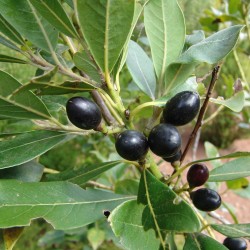
1000 de semințe de laur,...
Pret
95,00 €
(SKU: MHS 83)
Seeds Gallery EU,
5/
5
<meta http-equiv="Content-Type" content="text/html; charset=UTF-8" />
<h2><strong>1000 de semințe de laur, laur adevărat (Laurus nobilis)</strong></h2>
<h2><span style="color: #ff0000;"><strong>Preț pentru pachetul de 1000 de semințe.</strong></span></h2>
<p>The bay laurel, with the botanical name Laurus nobilis, of the plant family Lauraceae, is also known as sweet bay, bay tree (esp. United Kingdom), true laurel, Grecian laurel, laurel tree, or simply laurel.</p>
<p>It is an aromatic evergreen tree or large shrub with green, glossy leaves, native to the Mediterranean region. It is one of the plants used for bay leaf seasoning in cooking. Under the simpler name "laurel," Laurus nobilis figures prominently in classical Greek, Roman, and Biblical culture.</p>
<p>Worldwide, many other kinds of plants in diverse families are also called "bay" or "laurel," generally due to similarity of foliage or aroma to Laurus nobilis, and the full name is used for the California bay laurel (Umbellularia), also in the family Lauraceae.</p>
<h2><strong>Characteristics</strong></h2>
<p>The laurel can vary greatly in size and height, sometimes reaching 10–18 metres (33–59 ft) tall. Laurus is a genus of evergreen trees belonging to the Laurel family, Lauraceae. The genus includes three species, whose diagnostic key characters often overlap (Mabberley 1997).</p>
<p>The laurel is dioecious (unisexual), with male and female flowers on separate plants. Each flower is pale yellow-green, about 1 cm diameter, and they are borne in pairs beside a leaf. The leaves are 6–12 cm long and 2–4 cm broad, with an entire (untoothed) margin. On some leaves the margin undulates. The fruit is a small, shiny black berry (a drupe, actually) about 1 cm long.</p>
<p>A recent study found considerable genetic diversity within L. nobilis, and that L. azorica is not genetically or morphologically distinct.</p>
<h2><strong>Ecology</strong></h2>
<p>Laurus nobilis is a widespread relic of the laurel forests that originally covered much of the Mediterranean Basin when the climate of the region was more humid. With the drying of the Mediterranean during the Pliocene era, the laurel forests gradually retreated, and were replaced by the more drought-tolerant sclerophyll plant communities familiar today. Most of the last remaining laurel forests around the Mediterranean are believed to have disappeared approximately ten thousand years ago, although some remnants still persist in the mountains of southern Turkey, northern Syria, southern Spain, north-central Portugal, northern Morocco, Canary Islands and in Madeira.</p>
<h3><strong>Chemical constituents</strong></h3>
<p>The most abundant essential oil found in laurel is cineole, also called eucalyptol.[2] The leaves contain about 1.3% essential oils (ol. lauri folii), consisting of 45% eucalyptol, 12% other terpenes, 3–4% sesquiterpenes, 3% methyleugenol, and other α- and β-pinenes, phellandrene, linalool, geraniol, and terpineol.</p>
<p>Both essential and fatty oils are present in the fruit. The fruit is pressed and water-extracted to obtain these products. The fruit contains up to 30% fatty oils and about 1% essential oils (terpenes, sesquiterpenes, alcohols, and ketones).</p>
<h2><strong>Food</strong></h2>
<p>The plant is the source of several popular herbs and one spice used in a wide variety of recipes, particularly among Mediterranean cuisines.[2] Most commonly, the aromatic leaves are added whole to Italian pasta sauces. However, even when cooked, whole bay leaves can be sharp and abrasive enough to damage internal organs, so they are typically removed from dishes before serving, unless used as a simple garnish.[4] Whole bay leaves have a long shelf life of about one year, under normal temperature and humidity.[4] Bay leaves are used almost exclusively as flavor agents during the food preparation stage;</p>
<p>Ground bay leaves, however, can be ingested safely and are often used in soups and stocks, as well as being a common addition to a Bloody Mary.[4] Dried laurel berries and pressed leaf oil can both be used as robust spices, and even the wood can be burnt for strong smoke flavoring.</p>
<h2><strong>Traditional medicine</strong></h2>
<p>Aqueous extracts of bay laurel can also be used as astringents and even as a reasonable salve for open wounds.</p>
<p>In massage therapy, the essential oil of bay laurel is reputed to alleviate arthritis and rheumatism, while in aromatherapy, it is used to treat earaches and high blood pressure.[6][unreliable source?] A traditional folk remedy for rashes caused by poison ivy, poison oak, and stinging nettle is a poultice soaked in boiled bay leaves.</p>
<p>The chemical compound lauroside B isolated from Laurus nobilis is an inhibitor of human melanoma (skin cancer) cell proliferation at high concentrations.</p>
<h2><strong>Other uses</strong></h2>
<p>Bay is widely cultivated as an ornamental plant in regions with Mediterranean or oceanic climates, and as a house plant or greenhouse plant in colder regions. It is used in topiary to create single erect stems with ball-shaped, box-shaped or twisted crowns; also for low hedges. Together with a gold form, L. nobilis 'Aurea',[9] it has gained the Royal Horticultural Society's Award of Garden Merit.[10]</p>
<p>Laurel oil is a main ingredient, and the distinguishing characteristic of Aleppo soap.</p>
<h3><strong>Symbolism</strong></h3>
<p>Bay laurel was used to fashion the laurel wreath of ancient Greece, a symbol of highest status. A wreath of bay laurels was given as the prize at the Pythian Games because the games were in honor of Apollo, and the laurel was one of his symbols.</p>
<p>Ovid tells the story in the Metamorphoses that laurel tree was first formed when the nymph Daphne was changed into a laurel tree because of Apollo's pursuit of her. Daphne is the Greek name for the tree.</p>
<p>The symbolism carried over to Roman culture, which held the laurel as a symbol of victory.[12] It is also the source of the words baccalaureate and poet laureate, as well as the expressions "assume the laurel" and "resting on one's laurels".</p>
<p>In the Bible, the laurel is often an emblem of prosperity and fame. In Christian tradition, it symbolizes the resurrection of Christ.</p>
<p style="text-align: left;">In Chinese folklore, there is a great laurel tree on the moon, and the Chinese name for the laurel, (Chinese: 月桂), literally translates to "moon-laurel". This is the subject of a story of Wu Gang, a man who aspired to immortality and neglected his work. When the deities discovered this, they sentenced Wu Gang to fell the laurel tree, whereupon he could join the ranks of the deities; however, since the laurel regenerated immediately when cut, it could never be felled. The phrase (Chinese: 吴刚伐木) ("Wu Gang chops the tree") is sometimes used to refer to endless toil, analogous to the legend of Sisyphus in Greek mythology</p>
<h2>How to Germinate Bay Leaf Seeds</h2>
<p><span>Commonly used in cooking and herbal treatments, bay leaves come from the bay laurel (Laurus nobilis) tree, which grows in U.S. Department of Agriculture hardiness zones 8 through 10. Attempting to grow bay laurel trees from seed can sometimes be frustrating as the seeds typically have a long germination period and may begin rotting before germination begins. It is possible to germinate bay laurel seeds, though it is recommended that you attempt to germinate multiple seeds at once to allow for germination failure and rotting in some of the seeds.</span></p>
<p><strong>Soak the bay laurel seeds in warm water for 24 hours.</strong></p>
<p><strong>2</strong></p>
<p>Prepare a seed tray with a layer of starting soil. The soil should be moist but not saturated and there should be no standing water present in the tray.</p>
<p><strong>3</strong></p>
<p>Spread the seeds out over the tray, pressing them lightly into the moistened soil. The seeds should be approximately two inches apart to allow them room to spread out once they begin developing roots and shoots.</p>
<p><strong>4</strong></p>
<p>Cover the seeds with a thin layer of compost, mulch or horticultural sand. Spray the contents of the tray lightly with warm water to dampen the seed covering. As with the initial moistening of the soil, you only want to dampen the covering and not saturate it.</p>
<p><strong>5</strong></p>
<p>Place the seed tray in an area where it will receive up to eight hours of sunlight per day and will maintain a temperature of about 70 degrees Fahrenheit.</p>
<p><strong>6</strong></p>
<p>Moisten the seed tray as needed. You want the soil and the seed covering to remain moist, though being slightly on the dry side will not harm the seeds. It is better for the seeds to germinate in an environment that is only slightly moist than one that is saturated since the latter condition encourages rotting.</p>
<p><strong>7</strong></p>
<p>Check the progress of the seeds weekly. It may take as few as 10 days or as long as six months for the bay laurel seeds to begin germinating. If you notice any seeds that have begun to rot, remove them from the tray.</p>
<p><strong>8</strong></p>
<p>Transplant germinated seeds to pots or to a prepared location outdoors once leaves begin to appear.</p>
<p><strong>Tip</strong></p>
<p>Bay laurel trees can grow as tall as 40 feet outdoors but can also be trained to grow in a pot through regular pruning. Many growers prune even outdoor trees to keep them around 10 feet tall for easy harvesting of leaves.</p>
<p><strong>Warning</strong></p>
<p>Bay leaves can have sharp edges and may cause mouth or throat injuries if chopped and put into food. Leaves used in cooking should be whole or contained in packets made of cheesecloth or other materials so that they can be removed before serving.</p>
<p>
<script type="text/javascript"></script>
</p>
MHS 83 (500g)

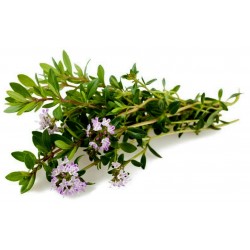
Semințe Cimbrul (Satureja...
Pret
2,15 €
(SKU: MHS 123)
Seeds Gallery EU,
5/
5
<h2><strong>Semințe Cimbrul (Satureja hortensis)</strong></h2>
<h2><span style="color: #ff0000;" class=""><strong>Preț pentru pachetul de 1600 (1g) semințe.</strong></span></h2>
<p><b>Cimbrul</b><span> </span>(<i>Satureja hortensis</i><span> </span>L.) numit și cimbru de grădină sau cimbru bun, este o<span> </span>plantă<span> </span>perenă din genul<span> </span>Satureja, familia labiatelor (Lamiaceae). Este o plantă scundă, care nu atinge mai mult de 20-30 centimetri în înălțime. Cimbrul preferă verile lungi, calde, secetoase, iar iarna supraviețuiește la temperaturi scăzute. Florile cimbrului sunt mici și au o culoare albă sau roz-palid. Frunzele au forma lanceolat-ovală, sunt netede și au un miros specific. Cimbrul se aseamănă întrucâtva la înfățișare cu<span> </span>rozmarinul.</p>
<h2><span class="mw-headline" id="Originea">Originea</span></h2>
<p>Cimbrul își are originile pe țărmurile europene ale Mării Mediterane.</p>
<p>În trecut, cimbrul se denumea și lămâiță, respectiv lămâioară și era deosebit de apreciat în Evul Mediu, mai ales în bucătăriile de pe lângă așezămintele monahale.</p>
<h2><span id="Compozi.C8.9Bia_chimic.C4.83"></span><span class="mw-headline" id="Compoziția_chimică">Compoziția chimică</span></h2>
<p>Funzele conțin apă (71,88%), substanțe azotoase (5,56%), zahăr (2,45%), substanțe extractive neazotate (9,16%), celuloză (8,60%), cenușă (2,11%), uleiuri eterice (0,5-2%), acid ursolic, acid oleanolic, tanin (4-8%), mucilagii, rezine, β-Sitosterină etc., vitaminele B₁, C.</p>
<h2><span class="mw-headline" id="Gastronomie">Gastronomie</span></h2>
<p>Este întrebuințat în diferite preparate culinare, mai ales în mâncarea de<span> </span>fasole, cea de<span> </span>linte, dar și la prepararea cărnii de porc și de vânat. Frunze și tulpini întregi de cimbru se introduc uneori în borcanele în care se murează<span> </span>varza<span> </span>și castraveții. Se folosește, de asemenea, la prepararea sarmalelor.</p>
<h2><span class="mw-headline" id="Cultivare">Cultivare</span></h2>
<p>Cimbrul, atâta timp cât este cultivat într-un loc bine însorit, se mulțumește cu puțin. Crește pe aproape orice tip de sol, rezistă la secetă, dar și la ploi abundente. Este în schimb o plantă sensibilă la buruieni, de aceea plivitul trebuie făcut cât mai des. Cele mai aromate frunze se recoltează atunci când plantele au început să înflorească.</p>
<h2><span id="Recoltare_.C8.99i_uscare"></span><span class="mw-headline" id="Recoltare_și_uscare">Recoltare și uscare</span></h2>
<p>Se recoltează partea aeriană a plantei, ramuri cu frunze și flori (Satureja herba). Perioada optimă de recoltare este la mijlocul epocii de înflorire, când peste 40-50% din plantă este înflorită.</p>
<p>Materia primă recoltată se usucă natural în poduri sau camere aerisite. Uscarea se face la umbră, ferit de contactul cu alte plante aromatice. Cimbrul se poate usca artificial în uscătoare, dar la o temperatură maximă de 35 de grade celsius datorită riscului de pierdere a principiilor active constituite de uleiurile volatile.</p>
<h2><span id="Cimbru_sau_cimbri.C8.99or.3F"></span><span class="mw-headline" id="Cimbru_sau_cimbrișor?">Cimbru sau cimbrișor?</span></h2>
<p>Cimbrul nu trebuie confundat cu<span> </span>cimbrișorul<span> </span>(Thymus serpyllum) care, deși înrudit cu cimbrul care crește spontan în<span> </span>România, aparține genului<span> </span>Thymus.</p>
<p>Cimbrișorul (Thymus serpyllum) denumit și<span> </span>iarba cucului<span> </span>sau<span> </span>tamâița, e tipic pajiștilor însorite alpine din<span> </span>Carpați<span> </span>și e folosit în medicina naturistă, la prepararea ceaiurilor contra răgușelilor și laringitelor. Mai este folosit, ca și<span> </span>maghiranul, și în gastronomie pentru a da aromă unor mâncăruri din carne de vită, legume sau pește.</p>
<p>În medicina naturistă, infuzia de cimbru uscat este deosebit de eficace în tratarea tusei rebele.</p>
<p>A nu se confunda cu<span> </span><i>Thymus vulgaris</i><span> </span>L. (Cimbru de câmp).</p><script src="//cdn.public.n1ed.com/G3OMDFLT/widgets.js"></script>
MHS 123 (1g)

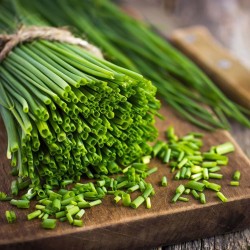
Semințe Arpagic (Allium...
Pret
1,75 €
(SKU: MHS 141)
Seeds Gallery EU,
5/
5
<meta http-equiv="Content-Type" content="text/html; charset=UTF-8" />
<h2><strong>Semințe Arpagic (Allium Schoenoprasum)</strong></h2>
<h2><span style="color: #ff0000;"><strong>Preț pentru un pachet de 200 de semințe.</strong></span></h2>
<p><b>Arpagicul</b><span> </span>(<i>Allium schoenoprasum</i>) este o<span> </span>plantă<span> </span>perenă, mică și robustă, din familia<span> </span>Liliaceae, înrudită cu<span> </span>ceapa.<span> </span>Bulbii<span> </span>săi mici, albi și alungiți, și frunzele subțiri și tubulare se dezvoltă grupat la baza<span> </span>tulpinii. Deasupra<span> </span>frunzelor<span> </span>cresc niște inflorescențe albăstrui sau liliachii, cu o formă sferică, dense și atrăgătoare. Frunzele de arpagic pot fi tăiate la nivelul solului pentru a fi folosite la condimentarea mâncărurilor.</p>
<p>Cunoscută sub denumirea populară de ”arpagic”, ”ceapă pitică”, ”cepşoară”, ”civetă”, Allium Schoenoprasum este o plantă nativă din Europa, Asia şi America de Nord.</p>
<p>Este o plantă erbacee perenă, mică şi robustă care formează bulbi asemeni cepei, cu care este înrudită.</p>
<p>Înălţimea variază între 20-30 cm.</p>
<p>Bulbii săi mici, uşor conici, albi şi frunzele subţiri şi tubulare, de culoare verde-închis se dezvoltă grupate la baza tulpinii formând tufe foarte dense.</p>
<p>Bulbii sunt atât de apropiaţi unii de alţii în cadrul tufei, încât rădăcinile lor se întrepătrund formând o masă compactă.</p>
<p>Frunzele sunt foarte subţiri când răsar, dar se îngroaşă odată cu îmbătrânirea plantei.</p>
<p>Deasupra frunzelor cresc nişte inflorescenţe albăstrui sau liliachii, de o formă sferică.</p>
<p>Planta înfloreşte în iunie.</p>
<p>Allium Schoenoprasum are aroma vie şi gustul picant caracteristic cepei obişnuite, dar cu nuanţe mult mai fine.</p>
<p>Odată cu îmbătrânirea plantei, gustul devine mai accentuat, rămânând a fi totuşi cel mai delicat dintre rudele sale<span> </span><em>Allium</em><span> </span>(usturoi, ceapă, praz, haşmă).</p>
<p>Planta are numeroase întrebuinţări culinare în întreaga lume.</p>
<p>Se consumă doar frunzele plantei, astfel că se recoltează frunzele de la nivelul solului atunci când au 5-13cm înălţime.</p>
<p>Frunzele cresc cu atât mai viguros, cu cât sunt tunse mai des.</p>
<p>Pentru a stimula planta să producă frunze noi, florile trebuie rupte.</p>
<p>Preferă solurile bogate nutritiv, drenate şi locurile însorite.</p>
<p>Este bine ca solul să fie menţinut umed, dar va rezista şi la uscăciune, cantitatea şi calitatea frunzelor desigur suferind.</p>
<table cellspacing="0" cellpadding="0" border="1">
<tbody>
<tr>
<td colspan="2" width="100%" valign="top">
<p><span style="background-color: #ffffff; color: #008000;"><strong>Sowing Instructions</strong></span></p>
</td>
</tr>
<tr>
<td valign="top" nowrap="nowrap">
<p><span style="background-color: #ffffff; color: #008000;"><strong>Propagation:</strong></span></p>
</td>
<td valign="top">
<p><span style="background-color: #ffffff; color: #008000;">Seeds</span></p>
</td>
</tr>
<tr>
<td valign="top" nowrap="nowrap">
<p><span style="background-color: #ffffff; color: #008000;"><strong>Pretreat:</strong></span></p>
</td>
<td valign="top">
<p><span style="background-color: #ffffff; color: #008000;">0</span></p>
</td>
</tr>
<tr>
<td valign="top" nowrap="nowrap">
<p><span style="background-color: #ffffff; color: #008000;"><strong>Stratification:</strong></span></p>
</td>
<td valign="top">
<p><span style="background-color: #ffffff; color: #008000;">0</span></p>
</td>
</tr>
<tr>
<td valign="top" nowrap="nowrap">
<p><span style="background-color: #ffffff; color: #008000;"><strong>Sowing Time:</strong></span></p>
</td>
<td valign="top">
<p><span style="background-color: #ffffff; color: #008000;">all year round </span></p>
</td>
</tr>
<tr>
<td valign="top" nowrap="nowrap">
<p><span style="background-color: #ffffff; color: #008000;"><strong>Sowing Depth:</strong></span></p>
</td>
<td valign="top">
<p><span style="background-color: #ffffff; color: #008000;">1 cm, Cover lightly with substrate</span></p>
</td>
</tr>
<tr>
<td valign="top" nowrap="nowrap">
<p><span style="background-color: #ffffff; color: #008000;"><strong>Sowing Mix:</strong></span></p>
</td>
<td valign="top">
<p><span style="background-color: #ffffff; color: #008000;">Coir or sowing mix + sand or perlite</span></p>
</td>
</tr>
<tr>
<td valign="top" nowrap="nowrap">
<p><span style="background-color: #ffffff; color: #008000;"><strong>Germination temperature:</strong></span></p>
</td>
<td valign="top">
<p><span style="background-color: #ffffff; color: #008000;">18-25 ° C</span></p>
</td>
</tr>
<tr>
<td valign="top" nowrap="nowrap">
<p><span style="background-color: #ffffff; color: #008000;"><strong>Location:</strong></span></p>
</td>
<td valign="top">
<p><span style="background-color: #ffffff; color: #008000;">bright + keep constantly moist not wet</span></p>
</td>
</tr>
<tr>
<td valign="top" nowrap="nowrap">
<p><span style="background-color: #ffffff; color: #008000;"><strong>Germination Time:</strong></span></p>
</td>
<td valign="top">
<p><span style="background-color: #ffffff; color: #008000;">3-6 weeks</span></p>
</td>
</tr>
<tr>
<td valign="top" nowrap="nowrap">
<p><span style="background-color: #ffffff; color: #008000;"><strong>Watering:</strong></span></p>
</td>
<td valign="top">
<p><span style="background-color: #ffffff; color: #008000;">Water regularly during the growing season</span></p>
</td>
</tr>
<tr>
<td valign="top" nowrap="nowrap">
<p><span style="background-color: #ffffff; color: #008000;"><strong> </strong></span></p>
</td>
<td valign="top">
<p><br /><span style="background-color: #ffffff; color: #008000;"><em>Copyright © 2012 Seeds Gallery - Saatgut Galerie - Galerija semena. </em><em>All Rights Reserved.</em><em></em></span></p>
<div></div>
</td>
</tr>
</tbody>
</table>
MHS 141 (200 S)


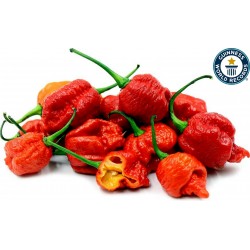
100 Seminte Carolina Reaper
Pret
5,50 €
(SKU: C 53 (0,47g))
Seeds Gallery EU,
5/
5
<!DOCTYPE html>
<html>
<head>
<meta http-equiv="Content-Type" content="text/html; charset=UTF-8" />
</head>
<body>
<h2><strong>100 Seminte Carolina Reaper</strong></h2>
<h2><span style="color: #ff0000;"><strong>Preț pentru pachetul de 100 (0,47g) de semințe.</strong></span></h2>
<p><strong>As you can see from our photos, that the seeds are from our own plants (organically grown) and you know what you will get from the seeds you buy from us... </strong></p>
<p>The Carolina Reaper, originally named the HP22BNH7, is a cultivar of chili pepper of the Capsicum chinense species. Bred in the Rock Hill, South Carolina greenhouse by Ed Currie, who runs the PuckerButt Pepper Company in Fort Mill, South Carolina, it has been rated as the world's hottest chili pepper by Guinness World Records since August 7, 2013. The original crossbreed was between a ghost pepper (a former world record holder) and a red habanero. The official Guinness World Record heat level is 1,569,300 Scoville Heat Units (SHU), according to tests conducted by Winthrop University in South Carolina.</p>
<p>At the second Annual New York City Hot Sauce Expo on 30 March 2014, Ed Currie was presented with his world record by Guinness World Records and an eating competition was held in which the fastest time to consume three Carolina Reapers was determined for a new Guinness World Records at 12.23 seconds by Russel Todd. This record was beaten in September 2014 by Jason McNabb, who finished three peppers in 10.95 seconds.</p>
</body>
</html>
C 53 (0,47g)

- La reducere!

Varietate din Statele Unite ale Americii

1500 semințe Heinz 1350 Tomate
Pret
12,95 €
(SKU: VT 101 (5g))
Seeds Gallery EU,
5/
5
<h2><strong>1500 semințe Heinz 1350 Tomate</strong></h2>
<h2><span style="color: #ff0000;"><strong>Preț pentru pachetul de 1500 (5g) semințe.</strong></span></h2>
<p><span class="VIiyi" jsaction="mouseup:BR6jm" jsname="jqKxS" lang="ro"><span jsaction="agoMJf:PFBcW;usxOmf:aWLT7;jhKsnd:P7O7bd,F8DmGf;Q4AGo:Gm7gYd,qAKMYb;uFUCPb:pvnm0e,pfE8Hb,PFBcW;f56efd:dJXsye;EnoYf:KNzws,ZJsZZ,JgVSJc;zdMJQc:cCQNKb,ZJsZZ,zchEXc;Ytrrj:JJDvdc;tNR8yc:GeFvjb;oFN6Ye:hij5Wb" jscontroller="Zl5N8" jsmodel="SsMkhd" jsname="txFAF" class="JLqJ4b ChMk0b" data-language-for-alternatives="ro" data-language-to-translate-into="en" data-phrase-index="4" jsdata="uqLsIf;_;$63"><span jsaction="click:qtZ4nf,GFf3ac,tMZCfe; contextmenu:Nqw7Te,QP7LD; mouseout:Nqw7Te; mouseover:qtZ4nf,c2aHje" jsname="W297wb">Savurați aroma clasică de roșii adăugând această moștenire în lista dvs. de grădină.</span></span> <span jsaction="agoMJf:PFBcW;usxOmf:aWLT7;jhKsnd:P7O7bd,F8DmGf;Q4AGo:Gm7gYd,qAKMYb;uFUCPb:pvnm0e,pfE8Hb,PFBcW;f56efd:dJXsye;EnoYf:KNzws,ZJsZZ,JgVSJc;zdMJQc:cCQNKb,ZJsZZ,zchEXc;Ytrrj:JJDvdc;tNR8yc:GeFvjb;oFN6Ye:hij5Wb" jscontroller="Zl5N8" jsmodel="SsMkhd" jsname="txFAF" class="JLqJ4b ChMk0b" data-language-for-alternatives="ro" data-language-to-translate-into="en" data-phrase-index="5" jsdata="uqLsIf;_;$64"><span jsaction="click:qtZ4nf,GFf3ac,tMZCfe; contextmenu:Nqw7Te,QP7LD; mouseout:Nqw7Te; mouseover:qtZ4nf,c2aHje" jsname="W297wb">Una dintre primele soiuri de semințe de roșii Heinz care a fost folosită pentru a face ketchup-ul Heinz, roșia Heinz Classic Heirloom (cunoscută și sub numele de Heinz 1370) oferă o aromă bogată de roșii în fructe mari (aproximativ 170g), suculente, ideale pentru felierea pe sandvișuri sau gătit</span></span> <span jsaction="agoMJf:PFBcW;usxOmf:aWLT7;jhKsnd:P7O7bd,F8DmGf;Q4AGo:Gm7gYd,qAKMYb;uFUCPb:pvnm0e,pfE8Hb,PFBcW;f56efd:dJXsye;EnoYf:KNzws,ZJsZZ,JgVSJc;zdMJQc:cCQNKb,ZJsZZ,zchEXc;Ytrrj:JJDvdc;tNR8yc:GeFvjb;oFN6Ye:hij5Wb" jscontroller="Zl5N8" jsmodel="SsMkhd" jsname="txFAF" class="JLqJ4b ChMk0b" data-language-for-alternatives="ro" data-language-to-translate-into="en" data-phrase-index="6" jsdata="uqLsIf;_;$65"><span jsaction="click:qtZ4nf,GFf3ac,tMZCfe; contextmenu:Nqw7Te,QP7LD; mouseout:Nqw7Te; mouseover:qtZ4nf,c2aHje" jsname="W297wb">în sosuri sau tocană.</span></span><span jsaction="agoMJf:PFBcW;usxOmf:aWLT7;jhKsnd:P7O7bd,F8DmGf;Q4AGo:Gm7gYd,qAKMYb;uFUCPb:pvnm0e,pfE8Hb,PFBcW;f56efd:dJXsye;EnoYf:KNzws,ZJsZZ,JgVSJc;zdMJQc:cCQNKb,ZJsZZ,zchEXc;Ytrrj:JJDvdc;tNR8yc:GeFvjb;oFN6Ye:hij5Wb" jscontroller="Zl5N8" jsmodel="SsMkhd" jsname="txFAF" class="JLqJ4b" data-language-for-alternatives="ro" data-language-to-translate-into="en" data-phrase-index="7" jsdata="uqLsIf;_;$66"><span jsaction="click:qtZ4nf,GFf3ac,tMZCfe; contextmenu:Nqw7Te,QP7LD; mouseout:Nqw7Te; mouseover:qtZ4nf,c2aHje" jsname="W297wb"> </span></span></span></p>
<p><span class="VIiyi" jsaction="mouseup:BR6jm" jsname="jqKxS" lang="ro"><span jsaction="agoMJf:PFBcW;usxOmf:aWLT7;jhKsnd:P7O7bd,F8DmGf;Q4AGo:Gm7gYd,qAKMYb;uFUCPb:pvnm0e,pfE8Hb,PFBcW;f56efd:dJXsye;EnoYf:KNzws,ZJsZZ,JgVSJc;zdMJQc:cCQNKb,ZJsZZ,zchEXc;Ytrrj:JJDvdc;tNR8yc:GeFvjb;oFN6Ye:hij5Wb" jscontroller="Zl5N8" jsmodel="SsMkhd" jsname="txFAF" class="JLqJ4b ChMk0b" data-language-for-alternatives="ro" data-language-to-translate-into="en" data-phrase-index="8" jsdata="uqLsIf;_;$67"><span jsaction="click:qtZ4nf,GFf3ac,tMZCfe; contextmenu:Nqw7Te,QP7LD; mouseout:Nqw7Te; mouseover:qtZ4nf,c2aHje" jsname="W297wb">Plantele (120-150 centimetri înălțime) prosperă în multe regiuni și se adaptează bine la creșterea în containere mari.</span></span> <span jsaction="agoMJf:PFBcW;usxOmf:aWLT7;jhKsnd:P7O7bd,F8DmGf;Q4AGo:Gm7gYd,qAKMYb;uFUCPb:pvnm0e,pfE8Hb,PFBcW;f56efd:dJXsye;EnoYf:KNzws,ZJsZZ,JgVSJc;zdMJQc:cCQNKb,ZJsZZ,zchEXc;Ytrrj:JJDvdc;tNR8yc:GeFvjb;oFN6Ye:hij5Wb" jscontroller="Zl5N8" jsmodel="SsMkhd" jsname="txFAF" class="JLqJ4b ChMk0b" data-language-for-alternatives="ro" data-language-to-translate-into="en" data-phrase-index="9" jsdata="uqLsIf;_;$68"><span jsaction="click:qtZ4nf,GFf3ac,tMZCfe; contextmenu:Nqw7Te,QP7LD; mouseout:Nqw7Te; mouseover:qtZ4nf,c2aHje" jsname="W297wb">Plantele Heinz Classic Heirloom poartă fructe pe tot parcursul sezonului, dar coacă cea mai grea porțiune a culturii vara.</span></span> <span jsaction="agoMJf:PFBcW;usxOmf:aWLT7;jhKsnd:P7O7bd,F8DmGf;Q4AGo:Gm7gYd,qAKMYb;uFUCPb:pvnm0e,pfE8Hb,PFBcW;f56efd:dJXsye;EnoYf:KNzws,ZJsZZ,JgVSJc;zdMJQc:cCQNKb,ZJsZZ,zchEXc;Ytrrj:JJDvdc;tNR8yc:GeFvjb;oFN6Ye:hij5Wb" jscontroller="Zl5N8" jsmodel="SsMkhd" jsname="txFAF" class="JLqJ4b ChMk0b" data-language-for-alternatives="ro" data-language-to-translate-into="en" data-phrase-index="10" jsdata="uqLsIf;_;$69"><span jsaction="click:qtZ4nf,GFf3ac,tMZCfe; contextmenu:Nqw7Te,QP7LD; mouseout:Nqw7Te; mouseover:qtZ4nf,c2aHje" jsname="W297wb">Mizați aceste plante viguroase pentru cele mai bune rezultate și recoltarea cea mai ușoară.</span></span></span><span> </span></p><script src="//cdn.public.n1ed.com/G3OMDFLT/widgets.js"></script>
VT 101 (5g)

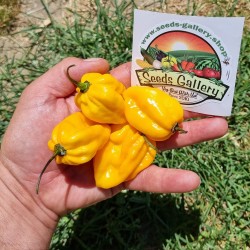
100 semințe galben habanero
Pret
5,95 €
(SKU: C 19 Y)
Seeds Gallery EU,
5/
5
<h2><span style="color: #000000;"><strong>100 semințe galben habanero</strong></span></h2>
<h2 class=""><span style="color: #f80000;"><strong>Prețul pentru un pachet de 100 de semințe.</strong></span></h2>
<div>The habanero is a variety of chili pepper. Unripe habaneros are green, and they color as they mature. The most common color variants are orange and red, but the fruit may also be white, brown, yellow, green, or purple. Typically, a ripe habanero chili is 2–6 cm (0.8–2.4 in) long. Habanero chilis are very hot, rated 100,000–650,000 on the Scoville scale. The habanero's heat, its flavor, and its floral aroma have made it a popular ingredient in hot sauces and spicy foods.<br><br>The name indicates something or someone from La Habana (Havana). In English, it is sometimes spelled and pronounced habañero, the tilde being added as a hyperforeignism patterned after jalapeño.<br><br><strong>Origin and current use</strong><br>The habanero chili comes from the Amazon, from which it was spread, reaching Mexico. A specimen of a domesticated habanero plant, dated at 8,500 years old, was found at an archaeological site in Peru.[citation needed] An intact fruit of a small domesticated habanero, found in pre-ceramic levels in Guitarrero Cave in the Peruvian highlands, was dated to 6500 BC.<br><br>The habanero chili was disseminated by Spanish colonists to other areas of the world, to the point that 18th-century taxonomists mistook China for its place of origin and called it Capsicum chinense ("the Chinese pepper").<br><br>Today, the largest producer is the Yucatán Peninsula, in Mexico. Habaneros are an integral part of Yucatecan food, accompanying most dishes, either in natural form or purée or salsa. Other modern producers include Belize, Panama, Costa Rica, Colombia, Ecuador, and parts of the United States, including Texas, Idaho, and California.<br><br>The Scotch bonnet is often compared to the habanero, since they are two varieties of the same species, but they have different pod types. Both the Scotch bonnet and the habanero have thin, waxy flesh. They have a similar heat level and flavor. Both varieties average around the same level of pungency, but the actual degree varies greatly from one fruit to another according to genetics, growing methods, climate, and plant stress.<br><br>In 1999, the habanero was listed by Guinness World Records as the world's hottest chili, but it has since been displaced by other peppers. The Bhut jolokia (or ghost pepper) and Trinidad moruga scorpion have since been identified as native Capsicum chinense subspecies even hotter than the habanero. Breeders constantly crossbreed subspecies to attempt to create cultivars that will break the record on the Scoville scale. One example is the Carolina Reaper, a cross between a Bhut jolokia pepper with a particularly pungent red habanero.<br><br><strong>Cultivation</strong><br>Habaneros thrive in hot weather. Like all peppers, the habanero does well in an area with good morning sun and in soil with a pH level around 5 to 6 (slightly acidic). Habaneros which are watered daily produce more vegetative growth but the same number of fruit, with lower concentrations of capsaicin, as compared to plants which are watered only when dry (every seven days). Overly moist soil and roots will produce bitter-tasting peppers. Daily watering during flowering and early setting of fruit helps prevent flower and immature fruit from dropping, but flower dropping rates are reported to often reach 90% even in ideal conditions.<br><br>The habanero is a perennial flowering plant, meaning that with proper care and growing conditions, it can produce flowers (and thus fruit) for many years. Habanero bushes are good candidates for a container garden. In temperate climates, though, it is treated as an annual, dying each winter and being replaced the next spring. In tropical and subtropical regions, the habanero, like other chiles, will produce year round. As long as conditions are favorable, the plant will set fruit continuously.<br><br><strong>Cultivars</strong><br>Several growers have attempted to selectively breed habanero plants to produce hotter, heavier, and larger peppers. Most habaneros rate between 200,000 and 300,000 on the Scoville scale. In 2004, researchers in Texas created a mild version of the habanero, but retained the traditional aroma and flavor. The milder version was obtained by crossing the Yucatán habanero pepper with a heatless habanero from Bolivia over several generations.</div>
<div></div>
<div>Black habanero is an alternative name often used to describe the dark brown variety of habanero chilis (although they are slightly different, being slightly smaller and slightly more sphere-shaped). Some seeds have been found which are thought to be over 7,000 years old. The black habanero has an exotic and unusual taste, and is hotter than a regular habanero with a rating between 400,000 and 450,000 Scoville units. Small slivers used in cooking can have a dramatic effect on the overall dish. Black habaneros take considerably longer to grow than other habanero chili varieties. In a dried form, they can be preserved for long periods of time, and can be reconstituted in water then added to sauce mixes. Previously known as habanero negro, or by their Nahuatl name, their name was translated into English by spice traders in the 19th century as "black habanero". The word "chocolate" was derived from the Nahuatl word, xocolātl [ʃoˈkolaːt͡ɬ], and was used in the description, as well (as "chocolate habanero"), but it proved to be unpronounceable to the British traders, so it was simply named "black habanero".<br><br>A 'Caribbean Red,' a cultivar within the habanero family, has a citrusy and slightly smoky flavor, with a Scoville rating ranging from 300,000 to 445,000 Scoville units.</div><script src="//cdn.public.n1ed.com/G3OMDFLT/widgets.js"></script>
C 19 Y (100 S)

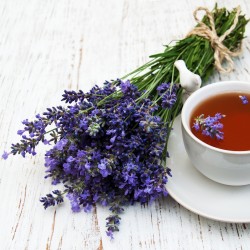
1kg Seminte de Isop de...
Pret
270,00 €
(SKU: MHS 112)
Seeds Gallery EU,
5/
5
<h2><strong>1kg Seminte de Isop de gradina (Hyssopus officinalis)</strong></h2>
<h2 class=""><span style="color: #ff0000;"><strong>Preț pentru pachet de 1.000.000 de semințe (1kg).</strong></span></h2>
<p>Specie perena foarte adaptabila, care necesita soluri medii, insorite si nu ridica prea multe multe pretentii in ce priveste umiditatea, ci dovedeste o buna toleranta la seceta. Se inmulteste, de regula prin rasad, perioada optima de plantare fiind in lunile iulie-august. La maturitate fiziologica plantele ajung la inaltimea de 60-80 cm, cu aspect de tufa si infloresc pentru prima data in anul al doilea de vegetatie. Este bine ca recoltatea frunzelor de isop sa se faca in perioada de inflorire, pentru a beneficia de deplinatatea aromei specifice si a calitatilor lor terapeutice.</p>
<p>Frunzele si tulpinile fragede de isop, in stare proaspata sau deshidratate, sunt agreate de cunoscatori pentru condimentarea unor specialitati gastronomice si garnisirea acestora.</p>
<p>Din prisma medicinii alopate si al practicilor traditionale isopul reprezinta o adevarata minune, inca din antichitate. Pe langa multiplele utilizari in industria farmaceutica, ceaiurile si infuziile de isop au influente majore in stimularea apetitului, in ameliorarea disfunctiilor gastrice si intestinale, in prevenirea si ameliorarea problemelor respiratorii in general si, in special, in tratarea iritatiilor cailor respiratorii, in reglarea tensiunii arteriale – avand calitati de vaso-dilatator etc.</p>
<script src="//cdn.public.n1ed.com/G3OMDFLT/widgets.js"></script>
MHS 112 (1kg)










